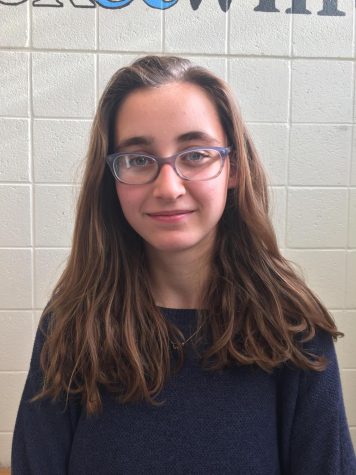Junior May Kalnik skates past her competitors in annual Regional Competition
April 11, 2019
“Double toe, toe loop, triple axel,” junior May Kalnik whispers as she ties the laces on her white figure skates. Kalnik visualizes her routine as she steps out onto the smooth ice and nervously glances at the judges across the rink. The music starts with a deafening boom, and Kalnik grins as she speeds into action.
Kalnik has been figure skating since she was seven years old, and she’s competed since fourth grade. Just three years ago, Kalnik placed fourth in the qualifying rounds of her first regionals competition. The following year, Kalnik moved to a higher regionals level and placed second.
“I really like the energy surrounding competitions,” Kalnik said. “I try to keep the same mindset for all of my competitions because if you start treating it differently, you might get more nervous before you compete.”
Competitive figure skating involves three different events: freestyle, which includes jumps and spins; moves, which focuses on the quality of turns and edges; and a subsection of freestyle called dance, performed in pairs. Kalnik usually competes in normal freestyle because she likes jumping, she said.
Kalnik’s competitions are held mostly in rinks around Bethesda against skaters from across the state. In preparation, Kalnik trains year-round on and off the ice. She skates three to four days a week at Cabin John Ice Rink and stretches and participates in off-ice workouts once or twice a week.
Kalnik has three coaches: one for freestyle, one for dance and one for off-ice training. Kalnik first trained with her current off-ice coach, Michael Lengyel, when she was eight. After a period of working with different coaches, Kalnik returned to working with Lengyel last spring. Lengyel, who occasionally watches Kalnik’s performances, noticed a major improvement in her performances.
“Between the time she left and the time she returned, she had developed physically and mentally into a determined young skater,” Lengyel said. “She has a natural endurance, and her reflexes are superior to those girls her age.”
Almost every off-ice practice involves a similar routine; Kalnik starts with rowing on an erg for 12 minutes or running, followed by a cardio, flexibility or strength workout involving weights.
Kalnik’s freestyle classes and off-ice training are one-on-one with her coach, while dance lessons are with friends. When Kalnik trains outside of lessons, she said she always brings a friend so they can help each other out.
“It’s like a community where sometimes if you’re struggling with something you can talk with your friends and take a break or you can ask them for help,” Kalnik said.
Every year, Kalnik competes in four major competitions. Because she’s a nervous competitor, Kalnik follows consistent pre-skate rituals where she warm-ups alone and runs through her routine in her head to reassure herself.
Kalnik’s mom, Sheryl Doran, always goes to Kalnik’s competitions and is proud of the results, she said. But Kalnik’s intense schedule has also taken up a lot of her and her mother’s time. Doran drives Kalnik to her lessons and the gym every week, drives to Fairfax to get Kalnik’s blades sharpened, goes to every competition and helps Kalnik choose her music and dresses.
Kalnik is looking to compete in more competitions this year. She’s specifically focused on training for the national competition in December.
“May’s determination is unrelenting. Her willingness to try and do anything asked and her ability to correct failed techniques and poor strategies is rewarding,” Lengyel said. “I have no doubt she will continue to develop into an amazing athlete.”








